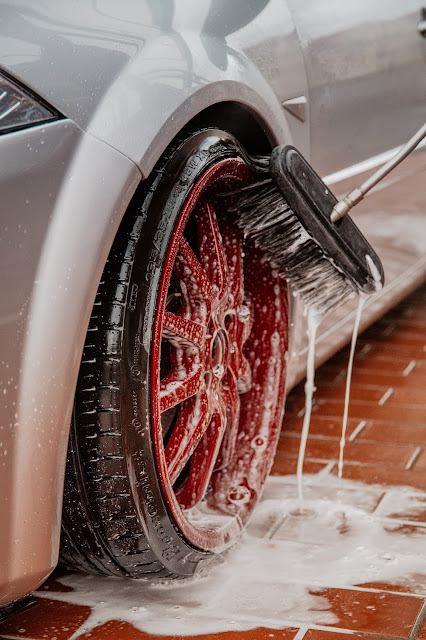Vehicle owners must complete maintenance services for their auto body, wheels, and tires. If they do not complete these tasks, they could see a depreciation of the value of their automobile. If they have alloy wheels, they will need to perform on-the-spot repairs if they collide with materials such as concrete, which could seriously damage the wheels.
Clean the Wheels
Before the auto owner can get started on repairing their alloy wheels, they need to clean them thoroughly and remove all the debris. When traveling, debris will stick to the wheels and cause damage. The auto owner can use a variety of automotive cleaning products to lift and remove the dirt and debris from the wheels. They can use spray foam that is designed specifically for alloy wheels and won't cause damage. If the results of cleaning the wheels reveal that they are too damaged, the auto owner can visit hammstires.com for replacement wheels.
Use Sandpaper to Smooth Damaged Paint and Chips
After the alloy wheels are cleaned, the owner can use sandpaper to remove damaged paint and chips to create a smoother surface. Sandpaper can smooth any jagged edges from the wheels and make them more aesthetically pleasing.
Chips and cracks make the alloy wheels look terrible, and the sandpaper creates smoother edges for the next step in the repair process. After they finish smoothing the edges, the owner must remove the dust and particles from the alloy wheels to prevent the it from collecting in the putty.
Fill in the Damaged Areas With Putty
All damaged areas must be filled with putty and smoothed over. They should push as much putty into the damaged spaces as possible. The putty will recreate the damaged spaces and make the wheel look more even. Once the holes are filled with putty, the owner must allow the putty to set and harden properly.
Next, they will use sandpaper to sand the putty until it is smooth against the wheel. It shouldn't bulge out of the damaged spaces, and it should adhere to the alloy wheel completely. They shouldn't have any edges that are jagged or that don't look like a piece of the wheel. The repaired section must be flush with the rest of the wheel.
Apply Masking Tape and Primer
Next, they will prepare the alloy wheel for the painting process, and they will apply masking tape around the entire affected area. The tape should stick into place and prevent paint from coating any other sections of the wheel.
If the paint goes beyond the target area, it could have aesthetically displeasing effects and make the wheels look terrible. Once the masking tape is in place, the owner can spray a primer over the entire affected area and wait for it to dry completely.
Apply Several Coats of Paint
After the primer has dried, the auto owner will review the surface and make sure that there aren't any air bubbles or imperfections. If a foreign object was trapped in the primer, they will need to remove it and resand the space. A new coat of primer will be needed to correct any imperfections, and they will have to wait for the primer to dry again.
When painting the alloy wheel, the auto owner will apply several coats of paint to cover the damaged area. It could take as many as five coats to recreate the look of the alloy wheels and create a perfect finish. They should allow the paint to dry completely and ensure that they didn't allow any dust or foreign objects to get into the paint.
Apply the Lacquer Over the Paint
Most repair kits come with a lacquer to provide a finish coat for the alloy wheel. The auto owner will need to apply the lacquer in coats, allowing each coat to dry individually. This will seal the paint and prevent it from chipping or wearing away as they drive their car.
If the repair kit didn't come with lacquer, the auto owner will need to purchase it to complete the repair process, and they will need to add at least three coats of lacquer to provide the best finish for the alloy wheels.
Will the Repairs Last?
When driving the vehicle, the owner will need to keep their alloy wheels and tires clean and prevent debris from building up on the metal. If the alloy wheels aren't managed properly, more damage could happen. If the auto owner hits a curb or collides with other objects, they could sustain more damage on their wheels and require new repairs or the need to replace the wheels.
When completing repairs, the auto owner must follow all instructions and ensure they do not deviate from any processes. If they miss a step, they will not repair the wheels properly and could find more damage later.
The paint and lacquer must be maintained on the wheels to prevent additional damage and to keep debris from eating through the paint. By performing simple maintenance steps, the owner can protect their wheels and keep them looking their best.
Auto owners can follow simple steps to repair their alloy wheels and make them look more aesthetically pleasing. The wheels are durable and long-lasting, but collisions with materials such as concrete could require the auto owner to get repairs. Simple steps such as filling in the holes with putty could create a better surface for the vehicles and give the owner a better finish.
If they can repair the damage, it is more cost-effective to perform these steps themselves. However, if the alloy wheels are too damaged, it may be time to replace them to avoid additional problems.

